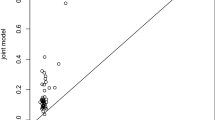Abstract
Conditional independence is a fundamental principle in latent variable modeling and item response theory. Violations of this principle, commonly known as local item dependencies, are put in a test information perspective, and sharp bounds on these violations are defined. A modeling approach is proposed that makes use of a mixture representation of these boundaries to account for the local dependence problem by finding a balance between independence on the one side and absolute dependence on the other side. In contrast to alternative approaches, the nature of the proposed boundary mixture model does not necessitate a change in formulation of the typical item characteristic curves used in item response theory. This has attractive interpretational advantages and may be useful for general test construction purposes.
Similar content being viewed by others
References
Ashford, J.R., & Sowden, R.R. (1970). Multivariate probit analysis. Biometrics, 26, 535–546.
Birnbaum, A. (1968). Some latent trait models and their use in inferring an examinee’s ability. In F.M. Lord & M.R. Novick (Eds.), Statistical theories of mental test scores (pp. 397–497). Reading: Addison-Wesley.
Braeken, J., & Tuerlinckx, F. (2009). A mixed model framework for teratology studies. Biostatistics, 10, 744–755.
Braeken, J., Tuerlinckx, F., & De Boeck, P. (2007). Copulas for residual dependency. Psychometrika, 72, 393–411.
Chen, W., & Thissen, D. (1997). Local dependence indexes for item pairs using item response theory. Journal of Educational and Behavioral Statistics, 22, 265–289.
Cureton, E.E. (1959). Note on φ/φ max . Psychometrika, 24, 89–91.
Ferrara, S., Huynh, H., & Michaels, H. (1999). Contextual explanations of local dependence in item clusters in a large-scale hands-on science performance assessment. Journal of Educational Measurement, 36, 119–140.
Fréchet, M. (1951). Sur les tableaux de corrélation dont les marges sont données. Annales de l’Université Lyon: Série 3, 14, 53–77.
Gibbons, R.D., & Hedeker, D.R. (1992). Full-information item bi-factor analysis. Psychometrika, 57, 423–436.
Hoeffding, W. (1940). Masstabinvariante Korrelations Theorie. Schriften des Matematischen Instituts und des Instituts für angewandte Mathematik der Universität Berlin, 5, 179–223. [Reprinted as Scale-invariant correlation theory in the Collected Works of Wassily Hoeffding, N.I. Fischer, and P.K. Sen (Eds.), New York: Springer.]
Hoskens, M., & De Boeck, P. (1997). A parametric model for local item dependencies among test items. Psychological Methods, 2, 261–277.
Ip, E. (2001). Testing for local dependence in dichotomous and polutomous item response models. Psychometrika, 66, 109–132.
Joe, H. (1997). Multivariate models and dependence concepts. London: Chapman & Hall.
Junker, B.W. (1991). Essential independence and likelihood-based ability estimation for polytomous items. Psychometrika, 56, 255–278.
Lazarsfeld, P.F. (1950). The logical and mathematical foundation of latent structure analysis & the interpretation and mathematical foundation of latent structure analysis. In S.A. Stouffer, L. Guttman, E.A. Suchman, P.F. Lazarsfeld, S.A. Star, & J.A. Claussen (Eds.), Measurement and prediction (pp. 7–56). Princeton University Press: Thousand Oaks.
Lord, F.M. (1980). Applications of item response theory to practical testing problems. Mahwah: Erlbaum.
MacCallum, R. (1986). Specification searches in covariance structure modeling. Psychological Bulletin, 100, 107–120.
Masters, G.N. (1988). Item discrimination: when more is worse. Journal of Educational Measurement, 25, 15–29.
Mood, A.M., Graybill, F.A., & Boes, D.C. (1974). Introduction to the theory of statistics. New York: McGraw-Hill.
Nelsen, R.B. (1998). An introduction to copulas. New York: Springer.
Salhi, S. (1998). Heuristic search methods. In G.A. Marcoulides (Ed.), Modern methods for business research (pp. 147–175). Mahwah: Lawrence Erlbaum.
Samejima, F. (1969). Estimation of latent ability using a response pattern of graded scores. Psychometrika Monograph Supplement, 7.
Samejima, F. (1972). A general model for free-response data. Psychometrika Monograph Supplement, 18.
Shaffer, J.P. (1995). Multiple hypothesis testing. Annual Review of Psychology, 46, 561–584.
Sireci, S.G., Thissen, D., & Wainer, H. (1991). On the reliability of testlet-based tests. Journal of Educational Measurement, 28, 237–247.
Sklar, A. (1959). Fonctions de répartition à n dimension et leurs marges. Publications Statistiques Université de Paris, 8, 229–231.
Steiger, J.H. (1990). Structural model evaluation and modification: An interval estimation approach. Multivariate Behavioral Research, 25, 173–180.
Tate, R. (2003). A comparison of selected empirical methods for assessing the structure of responses to test items. Applied Psychological Measurement, 27, 159–203.
Tuerlinckx, F., & De Boeck, P. (2001). Non-modeled item interactions lead to distorted discrimination parameters: A case study. Methods of Psychological Research, 6. [Retrieved May 20, 2005 from http://www.mpr-online.de/issue14/art3/Tuerlinckx.pdf.
Verhelst, N.D., & Glas, C.A.W. (1993). A dynamic generalization of the Rasch model. Psychometrika, 58, 395–415.
Wainer, H., Bradlow, E., & Wang, X. (2007). Testlet response theory and its applications. Cambridge: Cambridge University Press.
Yen, W.M. (1984). Effects of local item dependence on the fit and equating performance of the three-parameter logistic model. Applied Psychological Measurement, 8, 125–145.
Yen, W.M. (1993). Scaling performance assessments: Strategies for managing local item dependence. Journal of Educational Measurement, 30, 187–213.
Zeger, S.L., Liang, K.-Y., & Albert, P.S. (1988). Models for longitudinal data: A generalized estimation equation approach. Biometrics, 44, 1049–1060.
Author information
Authors and Affiliations
Corresponding author
Rights and permissions
About this article
Cite this article
Braeken, J. A Boundary Mixture Approach to Violations of Conditional Independence. Psychometrika 76, 57–76 (2011). https://doi.org/10.1007/s11336-010-9190-4
Received:
Revised:
Published:
Issue Date:
DOI: https://doi.org/10.1007/s11336-010-9190-4




